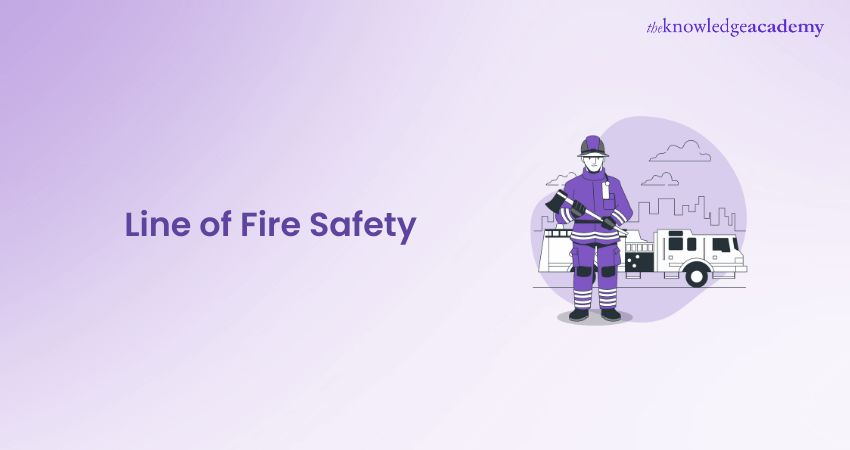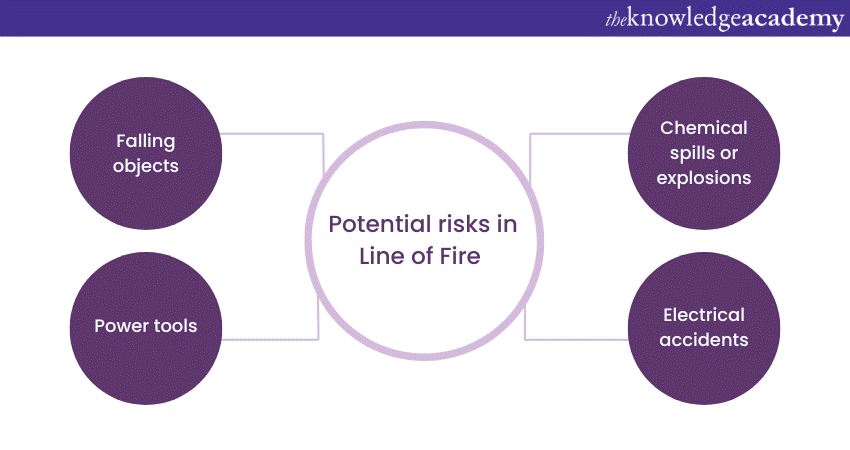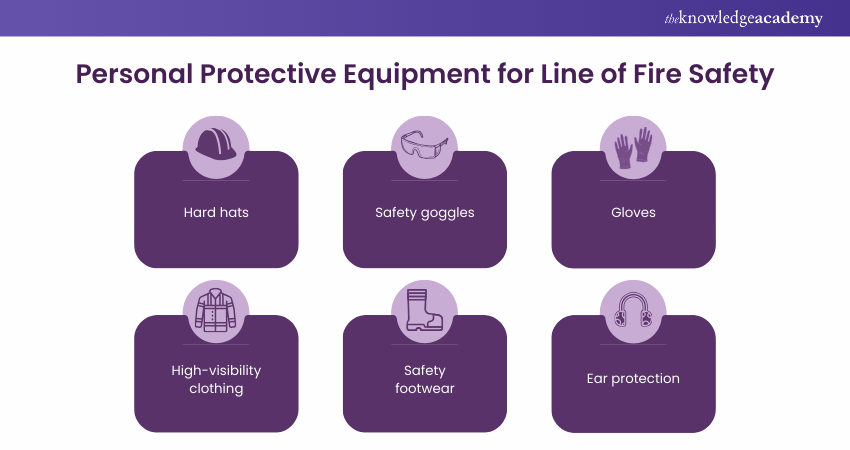We may not have the course you’re looking for. If you enquire or give us a call on 01344203999 and speak to our training experts, we may still be able to help with your training requirements.
We ensure quality, budget-alignment, and timely delivery by our expert instructors.

A workplace, while a haven for your financial ambitions, can often be a hotbed for invisible hazards. These dangers can strike without warning, be it fire, faulty electrical outlets, or falling pieces of machinery. Nothing is more important in a workplace than the workers' safety, and this is where Line of Fire Safety plays the role of a shield against these hazards.
In the financial year 2022-23, the UK's construction industry witnessed more than 923 non-fatal injuries related to handling, lifting, or contact with moving machinery. Such stats spotlight workers' safety as the topmost priority for employers. This blog outlines the most vital aspects of Line of Fire Safety, including Fire Safety, its importance, categories of hazard incidents, and various Personal Protective Equipment (PPE). Read on and strengthen safety measures in your workplace.
Table of Contents
1) What is Being in the Line of Fire?-
2) Potential Risks in Line of Fire
3) Why is Fire Safety Important?
4) What are the Major Categories of Line of Fire Hazard Incidents?
5) Personal Protective Equipment (PPE) for Line of Fire Safety
6)Conclusion
What is Being in the Line of Fire?
The term "being in the Line of Fire" carries significant implications for safety, particularly in industries like construction and manufacturing. However, its relevance extends to virtually any situation where potential harm may occur. When you're in the Line of Fire, you're directly in the path of a possible hazard.
This phrase conveys scenarios where individuals must be shielded from dangerous situations, such as moving heavy machinery, objects falling from a height, or even incidents involving chemical spills. In all these instances, individuals stand at the risk of severe harm and, hence, are considered "in the Line of Fire".
The Line of Fire doesn't always need to be a physical path of a moving object. It could also be the potential route of a hazardous energy discharge, such as an explosion or electrical arc. Therefore, understanding what being in the Line of Fire means is crucial to avoiding potentially dangerous situations and upholding safety measures, especially for those Responsible for Enforcing Fire Safety Legislation.

Potential Risks in Line of Fire
Being in the Line of Fire can expose individuals to a variety of risks, which can lead to numerous types of injuries. The nature of these injuries often depends on the type of work and the specific hazards involved. Here are some potential injuries associated with being in the Line of Fire:

1) Falling Objects: In a situation where an individual is underneath a load being hoisted at a construction site, they are within the Line of Fire. If the load were to fall, injuries could range from minor contusions and concussions to severe injuries such as fractures or even fatalities.
2) Power Tools: When a person is directly in the path of power tool operation, they are in the Line of Fire. Misuse or malfunction of power tools can result in a variety of injuries. This can include minor injuries like cuts and bruises or more severe injuries such as deep wounds, fractures, or in extreme cases, amputations.
Upgrade Your Safety: Explore Cutting-Edge Fire Safety Systems!
3) Chemical Spills or Explosions: Workers in the chemical industry can find themselves in the Line of Fire during a chemical spill or explosion. Possible injuries from such incidents include chemical burns, respiratory damage from inhaling toxic fumes, or even blindness if the eyes are not adequately protected.
4) Electrical Accidents: Workers within the Line of Fire during an electrical arc or explosion can suffer from severe burns, electrical shocks, or other related injuries. In severe cases, such incidents could lead to life-threatening situations or permanent disability.
Prevent fire hazards with our Fire Safety Course and build a safe workplace
Why is Fire Safety Important?
The importance of Line of Fire Safety revolves around taking preventative steps, including essential Fire Safety Tips, to alleviate these life-threatening risks. Promoting Fire Safety Awareness is a systematic approach, which is important due to the following reasons:
1) Regular Risk Assessments: Conducting routine risk evaluations is vital to identifying and removing potential hazards. These assessments should be thorough, covering every aspect of the work environment. This step is important as it Identifies and removes immediate threats, ensuring a safer workplace.
2) Adequate Training: Employees need to receive sufficient training to understand what constitutes the Line of Fire and the ways they can maintain their safety. This training is important as it empowers employees with knowledge, enabling them to avoid and counteract risks.
3) Safety Conscious Culture: Creating a safety-conscious culture is another vital aspect of Line of Fire Safety. This involves encouraging consistent communication about safety protocols and encouraging employees to share their safety concerns freely. A positive safety culture is important as it cultivates a proactive approach to safety, embedding it as a core value.
4) Open Reporting System: Establishing an environment where employees feel at ease reporting hazards or safety incidents is crucial. An open reporting system is important as it facilitates rapid response to threats, reducing potential harm and fostering trust.
Learn to identify different fire hazards with our Fire Warden Training!
What are the Major Categories of Line of Fire Hazard Incidents?
Line of Fire incidents are classified into three major categories: Caught-in or between, struck-by, and released energy. Let's look at each one in detail:
a)Caught-in or Between
This is when someone gets trapped in or between the equipment. It is the most frequent type of Line of Fire incident. A common example is when a Machine Operator's clothes get entangled in the moving parts because there is no proper machine guarding.
b)Struck-by
This is when someone gets hit by an object that flies out of the equipment. It is very risky and often causes death. A typical example is when a Carpenter is cutting wood with a power saw, and the blade snaps, sending it flying towards another worker.
c)Released Energy
This is when energy, such as electricity, escapes from the equipment. It is also very hazardous and often causes death. An example is when a machine that is overloaded or a pressure container that is not maintained properly bursts into flames.
Protect Your Home: Discover 5 Fire Safety Precautions You Can Take Now!
Personal Protective Equipment (PPE) for Line of Fire Safety
Personal Protective Equipment (PPE) is essential in Line of Fire Safety. Using PPE can serve as an additional safeguard against potential risks, bolstering safety measures and reducing the likelihood of injuries. Here are some examples of PPE commonly used to enhance Line of Fire Safety, including Fire Safety Equipment like fire-resistant clothing and firefighting gear.

1) Hard Hats: These protect the head from falling objects or impacts, especially relevant in industries like construction where there's a high risk of objects falling from above.
2) Safety Goggles: These can shield the eyes from flying debris, splashes of hazardous substances, or sparks, especially in roles involving the use of power tools or handling chemicals.
3) Gloves: Depending on the type, gloves can protect hands from a variety of hazards such as cuts, burns, electric shocks or chemical exposure.
4) High-visibility Clothing: This type of clothing is often used in areas with vehicular traffic or heavy machinery to ensure workers are clearly visible. This reduces the risk of accidents.
5) Safety Footwear: Specialised footwear can protect the feet from falling objects, sharp objects, or electrical hazards.
6) Ear Protection: In noisy environments, ear protection can help prevent damage to hearing, which could otherwise lead to accidents due to miscommunication or lack of awareness.
Ensure Safety: Download Your Fire Risk Assessment Checklist!
Conclusion
Line of Fire Safety is an essential component of establishing a secure and hazard-free work environment. A clear understanding of Fire Warden Duties is crucial for ensuring the effective implementation of Line of Fire Safety procedures. By identifying and mitigating direct hazards, we can significantly reduce the risk of injuries and protect the well-being of employees. Implementing these safety measures not only safeguards lives but also strengthens workplace security and fosters a culture of safety awareness and responsibility.
Learn about colour codes in fire extinguishers with our Fire Extinguisher Training- Sign up now!
Frequently Asked Questions
What is the Line of Sight and Line of Fire?

In Fire Safety, a line of sight or line of fire refers to a situation where a worker is directly in the path of a possible hazard, such as falling objects, moving heavy machinery or chemical spills.
What is the First Response to a Fire?

The first response to a fire is to warn others around you and activate the nearest fire alarm. This ensures that everyone is aware of the danger and can start evacuating safely.
What are the Other Resources and Offers Provided by The Knowledge Academy?

The Knowledge Academy takes global learning to new heights, offering over 3,000 online courses across 490+ locations in 190+ countries. This expansive reach ensures accessibility and convenience for learners worldwide.
Alongside our diverse Online Course Catalogue, encompassing 19 major categories, we go the extra mile by providing a plethora of free educational Online Resources like News updates, Blogs, videos, webinars, and interview questions. Tailoring learning experiences further, professionals can maximise value with customisable Course Bundles of TKA.
What is The Knowledge Pass, and How Does it Work?

The Knowledge Academy’s Knowledge Pass, a prepaid voucher, adds another layer of flexibility, allowing course bookings over a 12-month period. Join us on a journey where education knows no bounds.
What are the Related Courses and Blogs Provided by The Knowledge Academy?

The Knowledge Academy offers various Fire Safety Courses, including the Fire Risk Assessment Course and the Fire Extinguisher Course. These courses cater to different skill levels, providing comprehensive insights into Fire Safety Legislation. Our Health & Safety Blogs cover a range of topics related to Fire Safety, offering valuable resources, best practices, and industry insights. Whether you are a beginner or looking to advance your Fire Safety skills, The Knowledge Academy's diverse courses and informative blogs have got you covered.
Upcoming Health & Safety Resources Batches & Dates
Date
 Fire Safety Training
Fire Safety Training
Fri 27th Jun 2025
Fri 26th Sep 2025
Fri 21st Nov 2025






 Top Rated Course
Top Rated Course


 If you wish to make any changes to your course, please
If you wish to make any changes to your course, please


